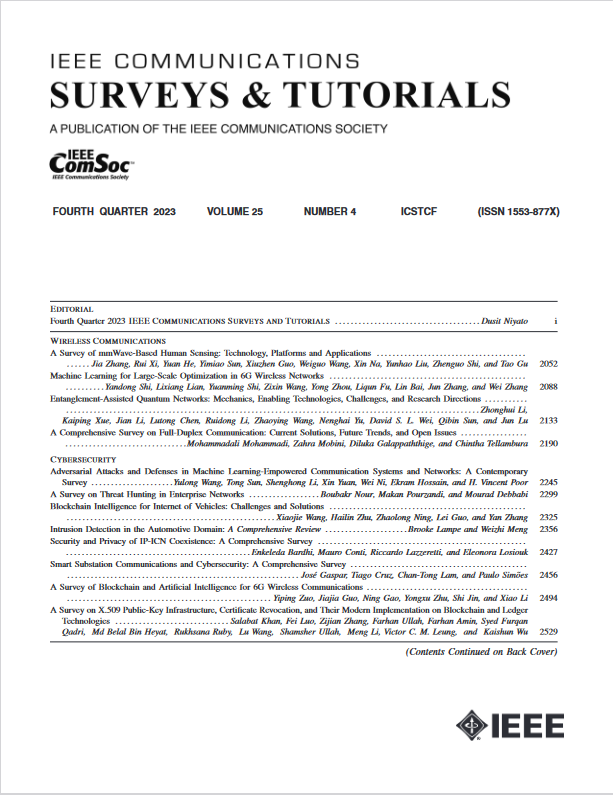关于 NYUSIM 的教程:面向 5G、6G 及更高频率的次太赫兹和毫米波信道模拟器
IF 34.4
1区 计算机科学
Q1 COMPUTER SCIENCE, INFORMATION SYSTEMS
引用次数: 0
摘要
随着无线通信向亚太赫兹(THz)和毫米波(mmWave)频段发展,精确的信道模型和仿真工具对于各种频率和场景的建模变得越来越重要。本文提供了使用基于开源 MATLAB 的纽约大学信道模型仿真器(NYUSIM)生成基于空投和空间一致性的信道的综合教程。NYUSIM 建立在 0.5-150 GHz 频率范围内大量实际无线电传播测量的基础上,涵盖城市微蜂窝 (UMi)、城市宏蜂窝 (UMa)、农村宏蜂窝 (RMa)、室内热点 (InH) 和室内工厂 (InF) 等多种场景。此外,我们还概述了自蜂窝通信早期以来用于设计和分析无线系统的模拟器的发展历程。我们介绍了学术界和工业界最常用的模拟器类型,如信道模拟器 (CS)、链路级模拟器 (LLS)、系统级模拟器 (SLS) 和网络模拟器 (NS),用于研究 5G 及以后的无线通信系统。由于各种模拟器广泛采用第三代合作伙伴计划(3GPP)随机信道模型(SCM)生成信道,我们对 3GPP SCM 和 NYUSIM 信道模型进行了比较分析,以突出它们之间的差异。此外,NYUSIM 的多功能性不仅限于其 MATLAB 实现,因为它可以在各种 LLS、SLS 和 NS 中实现,从而使研究人员能够将真实世界中基于测量的信道纳入其仿真中。为了说明这种能力,我们展示了 NYUSIM 在 ns-3 中的实现,ns-3 是一种广泛使用的开源离散事件网络模拟器。此外,我们还提供了 NYUSIM 的几个应用,以突出其潜在用途。本文章由计算机程序翻译,如有差异,请以英文原文为准。
A Tutorial on NYUSIM: Sub-Terahertz and Millimeter-Wave Channel Simulator for 5G, 6G, and Beyond
With the advancement of wireless communication to sub-terahertz (THz) and millimeter-wave (mmWave) bands, accurate channel models and simulation tools are becoming increasingly important for modeling a wide range of frequencies and scenarios. This paper provides a comprehensive tutorial on generating drop-based and spatial consistency-based channels using the open-source MATLAB-based NYU Channel Model Simulator (NYUSIM). NYUSIM is built on extensive real-world radio propagation measurements for the frequency range of 0.5–150 GHz, covering a variety of scenarios such as Urban Microcell (UMi), Urban Macrocell (UMa), Rural Macrocell (RMa), Indoor Hotspot (InH), and Indoor Factory (InF). Additionally, an overview of the evolution of simulators used to design and analyze wireless systems since the early days of cellular communication is also provided. We introduce the most popular types of simulators used in academia and industry, such as Channel Simulators (CSs), Link Level Simulators (LLSs), System Level Simulators (SLSs), and Network Simulators (NSs), to study wireless communication systems for 5G and beyond. Owing to the widespread adoption of the 3rd Generation Partnership Project (3GPP) Stochastic Channel Model (SCM) for channel generation in various simulators, we conduct a comparative analysis between the 3GPP SCM and NYUSIM channel model to highlight their differences. Moreover, NYUSIM’s versatility extends beyond its MATLAB implementation, as it can be implemented in various LLSs, SLSs, and NSs, enabling researchers to incorporate real-world measurement-based channels into their simulations. To illustrate this capability, we showcase NYUSIM’s implementation in ns-3, a widely used open-source discrete event network simulator. Additionally, we provide several applications of NYUSIM to highlight its potential uses.
求助全文
通过发布文献求助,成功后即可免费获取论文全文。
去求助
来源期刊

IEEE Communications Surveys and Tutorials
COMPUTER SCIENCE, INFORMATION SYSTEMS-TELECOMMUNICATIONS
CiteScore
80.20
自引率
2.50%
发文量
84
审稿时长
6 months
期刊介绍:
IEEE Communications Surveys & Tutorials is an online journal published by the IEEE Communications Society for tutorials and surveys covering all aspects of the communications field. Telecommunications technology is progressing at a rapid pace, and the IEEE Communications Society is committed to providing researchers and other professionals the information and tools to stay abreast. IEEE Communications Surveys and Tutorials focuses on integrating and adding understanding to the existing literature on communications, putting results in context. Whether searching for in-depth information about a familiar area or an introduction into a new area, IEEE Communications Surveys & Tutorials aims to be the premier source of peer-reviewed, comprehensive tutorials and surveys, and pointers to further sources. IEEE Communications Surveys & Tutorials publishes only articles exclusively written for IEEE Communications Surveys & Tutorials and go through a rigorous review process before their publication in the quarterly issues.
A tutorial article in the IEEE Communications Surveys & Tutorials should be designed to help the reader to become familiar with and learn something specific about a chosen topic. In contrast, the term survey, as applied here, is defined to mean a survey of the literature. A survey article in IEEE Communications Surveys & Tutorials should provide a comprehensive review of developments in a selected area, covering its development from its inception to its current state and beyond, and illustrating its development through liberal citations from the literature. Both tutorials and surveys should be tutorial in nature and should be written in a style comprehensible to readers outside the specialty of the article.
 求助内容:
求助内容: 应助结果提醒方式:
应助结果提醒方式:


